Market
Bitcoin (BTC) Price Could Surge with Interest Rate Cuts Looming

Bitcoin (BTC) price faces uncertainty as market trends and macroeconomic factors clash. Strong job growth could prompt the Federal Reserve to cut interest rates, potentially benefiting Bitcoin by increasing liquidity.
However, recent exchange flows show a balance between outflows and inflows, signaling no clear price direction yet. BTC needs to break resistance around $63,000 to push higher, but if it falls below the $59,000 support, it risks a drop to $55,000 or lower.
Booming Job Market: A Mixed Blessing for BTC Future?
The strong job growth and market optimism are a double-edged sword for Bitcoin. On one hand, the positive economic outlook could reduce the urgency for investors to turn to riskier assets like BTC, as traditional stocks may offer safer returns in a stable environment.
Additionally, the potential for the Federal Reserve to cut interest rates less aggressively could strengthen the U.S. dollar, potentially decreasing BTC appeal as an inflation hedge.
On the flip side, if the economy continues to grow without overheating, it could increase overall investor confidence, prompting more speculative investments, which could benefit BTC. Furthermore, the possibility of a slower rate of interest cuts may keep liquidity high, which tends to benefit high-risk assets like Bitcoin.
In short, while a strong economy might curb some of Bitcoin’s safe-haven appeal, it could still attract investors looking for growth opportunities in a positive market environment.
Bitcoin’s Balancing Act: Indecisive Net Exchange Flows
In the past month, net outflows from exchanges have dominated Bitcoin’s movement, but the trend is not as clear-cut as it may initially seem.
On September 10, we saw the largest outflow, reaching a month-low of -16,000 BTC, which is typically a strong bullish signal as it indicates holders are moving a significant amount of Bitcoin off exchanges, reducing the supply available for selling. However, after that large outflow, the pattern has been less decisive.
Read more: 7 Best Crypto Exchanges in the USA for Bitcoin (BTC) Trading
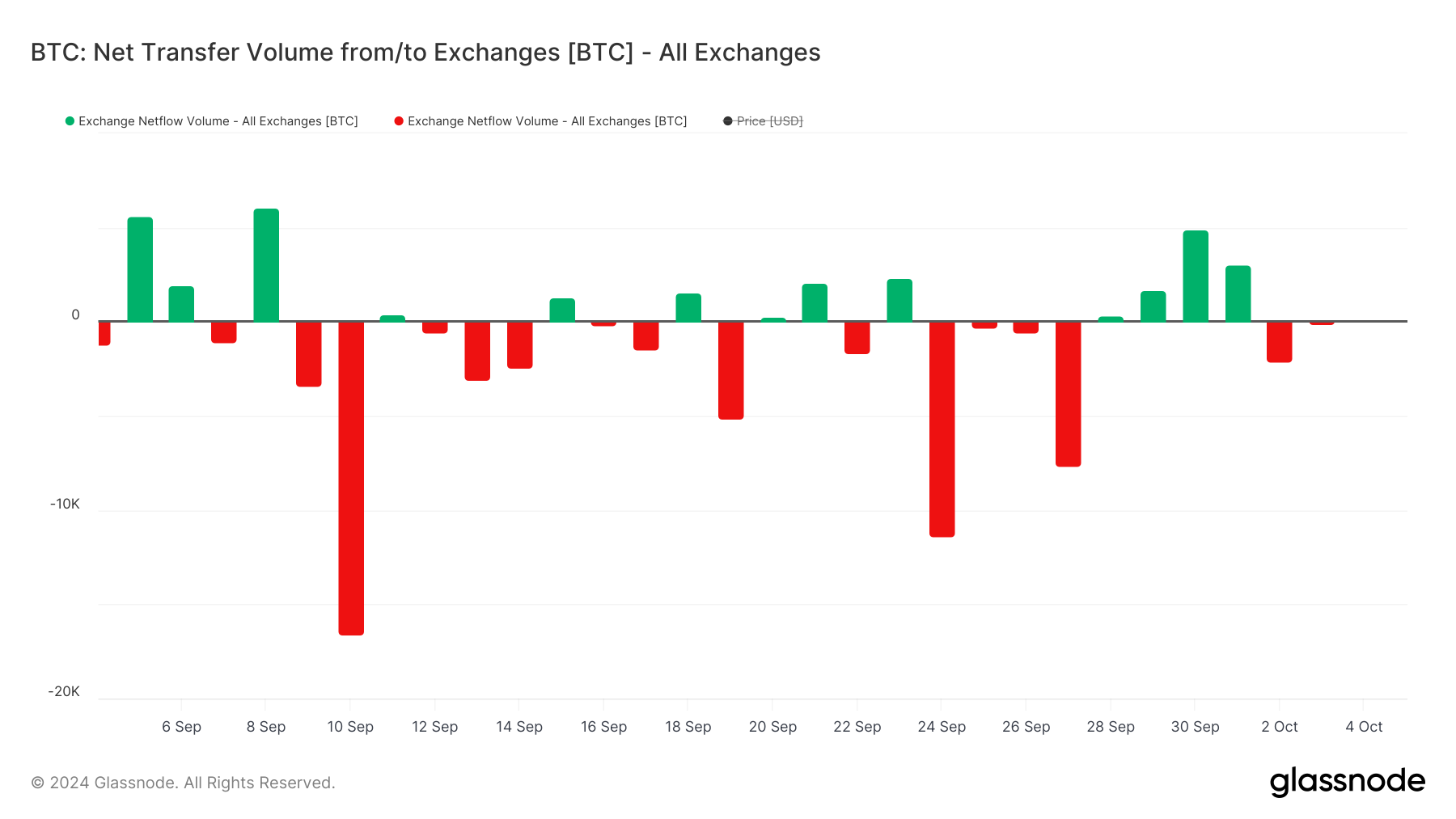
While negative flows continued, indicating more outflows than inflows overall, they haven’t been as extreme, and we’ve also seen several days with positive flows. These inflows suggest that some investors are still sending BTC to exchanges, possibly to sell, which adds to the market’s uncertainty.
This back-and-forth between outflows and inflows reflects a market without a dominant trend. While there is still a preference for holding overselling, it isn’t overwhelming enough to drive Bitcoin’s price strongly upward.
With inflows and outflows balancing each other more recently, BTC price trend remains indecisive, and the market could shift in either direction depending on how future inflows or outflows shape up.
BTC Price Prediction: A Potential 10% Jump Soon?
If the labor market continues to produce strong job numbers, as with the recent surge of 254,000 jobs in September, it could influence the Federal Reserve to cut interest rates further. A rate cut typically lowers borrowing costs and injects more liquidity into the economy, which can drive investors towards riskier assets like Bitcoin as they seek higher returns.
This scenario could positively impact BTC price by increasing demand, especially as lower interest rates make traditional investment avenues less attractive. If Bitcoin manages to break through its key resistances around $63,000 and $64,700, it could spark a rally toward $66,000 or higher as investors shift their focus to crypto.
Read more: Bitcoin (BTC) Price Prediction 2024/2025/2030

The In/Out of the Money Around Price (IOMAP) chart, which shows where BTC holders are “in the money” (profitable) or “out of the money” (at a loss), reveals significant support and resistance levels near the current price. However, if BTC price fails to hold its current support of around $59,000, it risks a sharper downside.
A break below this level could trigger a more substantial retracement, with BTC potentially falling to $55,000 or even $53,000, where the next significant support levels are found. This would likely encourage further selling pressure, especially from traders looking to cut their losses, pushing Bitcoin into a more bearish phase unless broader economic factors, like rate cuts, help revive the bullish momentum.
Disclaimer
In line with the Trust Project guidelines, this price analysis article is for informational purposes only and should not be considered financial or investment advice. BeInCrypto is committed to accurate, unbiased reporting, but market conditions are subject to change without notice. Always conduct your own research and consult with a professional before making any financial decisions. Please note that our Terms and Conditions, Privacy Policy, and Disclaimers have been updated.
Market
Ethereum Struggles to Break Out as Bear Trend Fades

Ethereum (ETH) enters the week with mixed signals as traders brace for tomorrow’s “Liberation Day” tariff announcement, a potential macro catalyst that could impact risk assets. While the BBTrend indicator remains deeply negative, it’s beginning to ease, hinting at a possible slowdown in bearish momentum.
On-chain data shows a slight uptick in whale accumulation, suggesting cautious optimism from large holders. Meanwhile, Ethereum’s EMA setup shows early signs of a trend reversal, but the price still needs to break key resistance levels to confirm a shift in direction.
ETH BBTrend Is Easing, But Still Very Negative
Ethereum’s BBTrend indicator is currently reading -11.66, slightly improved from -12.54 the day before, but still in negative territory for the second consecutive day.
The Bollinger Band Trend (BBTrend) measures the strength and direction of a trend based on how price interacts with the upper and lower Bollinger Bands.
A positive BBTrend suggests bullish momentum, with the price expanding toward the upper band, while a negative BBTrend indicates bearish momentum, with the price leaning toward the lower band. Typically, a value beyond 10 is considered a strong trend signal, making the current -11.66 reading a sign of continued downside pressure.

The persistent negative BBTrend suggests that Ethereum remains in a short-term bearish phase, with sellers still dominating the price action.
While yesterday’s slight uptick hints at a potential slowing of downward momentum, the indicator remains well below the neutral zone, meaning any reversal is still unconfirmed, despite Ethereum flipping Solana in DEX trading volume for the first time in 6 months.
Traders may interpret this as a warning to stay cautious, especially if ETH continues hugging the lower Bollinger Band. For now, price action remains fragile, and any bounce will need to be supported by a decisive shift in volume and sentiment to signal a meaningful reversal.
Ethereum Whales Are Accumulating Again
The number of Ethereum whales—wallets holding between 1,000 and 10,000 ETH—has ticked up slightly, rising from 5,322 to 5,330 in the past 24 hours.
While this is a modest increase, whale activity remains one of the most closely watched on-chain metrics, as these large holders often influence market direction. Whales’ accumulation can signal growing confidence in Ethereum’s medium—to long-term prospects, especially during periods of price uncertainty or consolidation.
Conversely, a decline in whale addresses typically suggests weakening conviction or profit-taking.
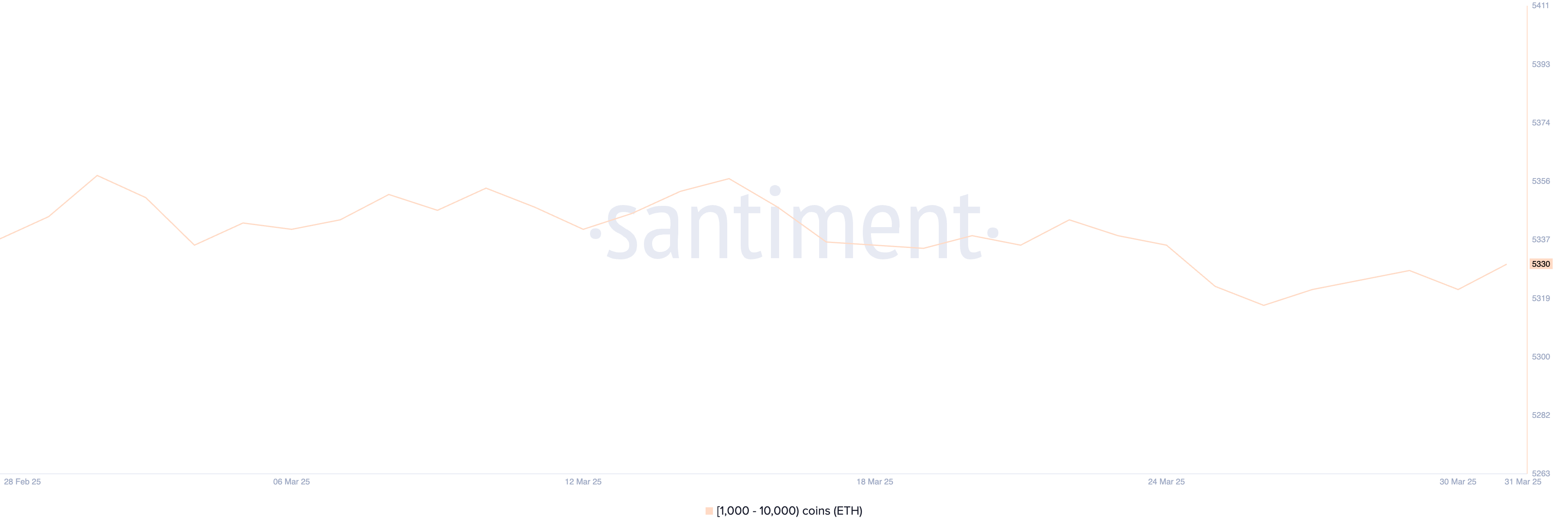
Although the recent uptick is a positive sign, it’s important to note that the current number of Ethereum whales is still below the levels observed in prior weeks.
This means that while some large holders may be re-entering the market, the broader whale cohort has yet to fully commit to an accumulation phase.
If the upward trend in whale numbers continues, it could support a bullish shift in sentiment and price. However, for now, the data points to cautious optimism rather than a decisive reversal.
Will Ethereum Break Above $2,100 Soon?
Ethereum’s EMA lines are showing early signs of a potential trend reversal, with price action attempting to break above key short-term averages.
If Ethereum price can push through the resistance at $1,938, it may signal the start of a broader recovery, potentially targeting the next resistance levels at $2,104, and if momentum builds—especially with supportive macro catalysts—increasing toward $2,320 and even $2,546.
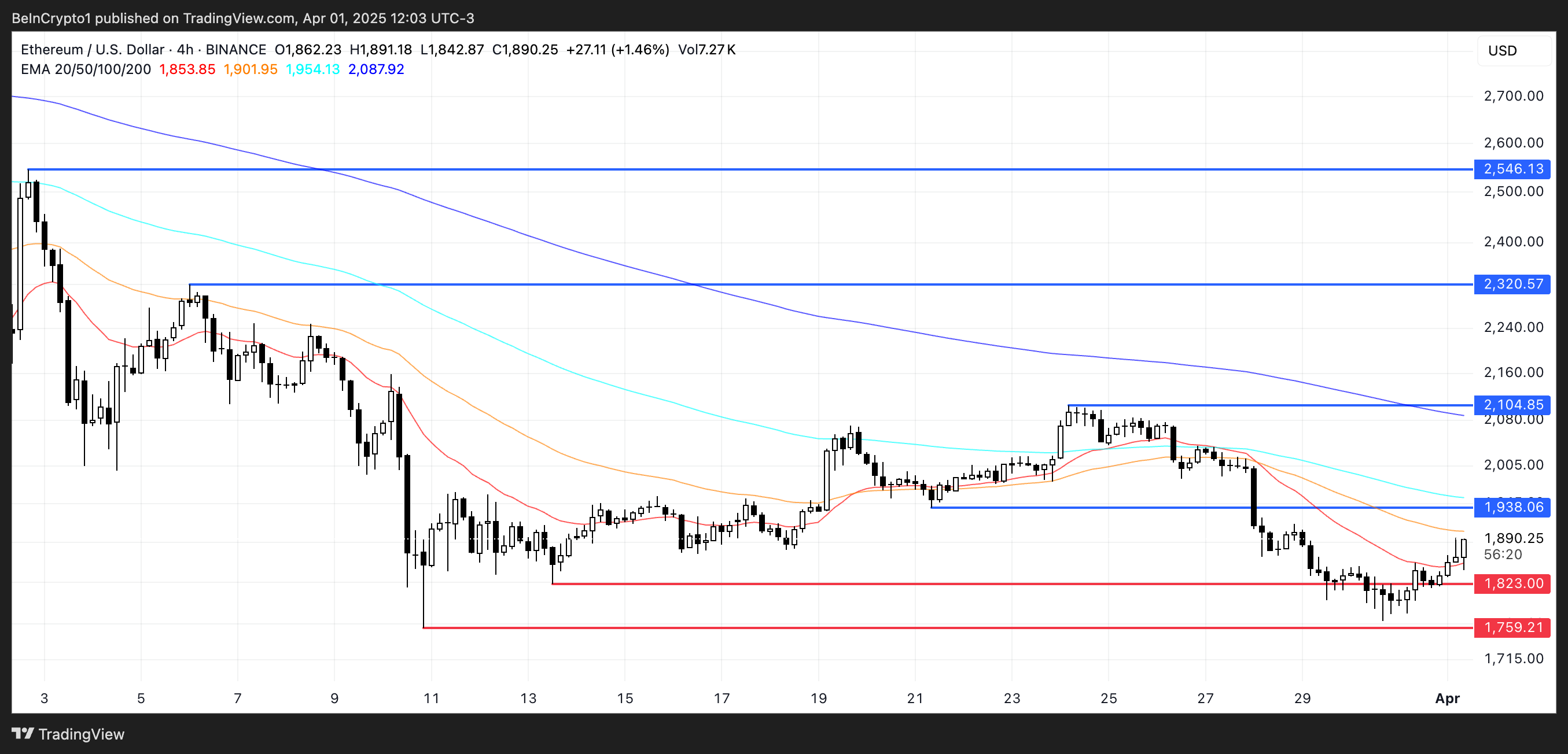
On the flip side, if Ethereum fails to maintain its upward push and bearish momentum resumes, the focus will shift back to downside levels.
The first key support sits at $1,823; a break below that could expose Ethereum to further losses toward $1,759.
Disclaimer
In line with the Trust Project guidelines, this price analysis article is for informational purposes only and should not be considered financial or investment advice. BeInCrypto is committed to accurate, unbiased reporting, but market conditions are subject to change without notice. Always conduct your own research and consult with a professional before making any financial decisions. Please note that our Terms and Conditions, Privacy Policy, and Disclaimers have been updated.
Market
Binance Megadrop Launches KernelDAO

Binance Megadrop has announced its fourth project – KernelDAO (KERNEL), a restaking protocol supporting three key tokens Kernel, Kelp, and Gain.
Introduced in 2024, Binance Megadrop is a token launch platform that provides users with early access to promising crypto projects before their official listing.
KernelDAO and Binance Megadrop: Overview
KernelDAO is a restaking protocol that allows users to repurpose staked assets (such as ETH or BNB) to participate in other protocols, maximizing yield. The protocol launched its mainnet in December 2024.
The KernelDAO Megadrop event kicks off on April 1, 2025, and lasts for 20 days, rewarding participants with KERNEL tokens. Kelp, a KernelDAO component, manages over $1.15 billion in Total Value Locked (TVL) across 10 blockchains, including Ethereum and BNB Chain.
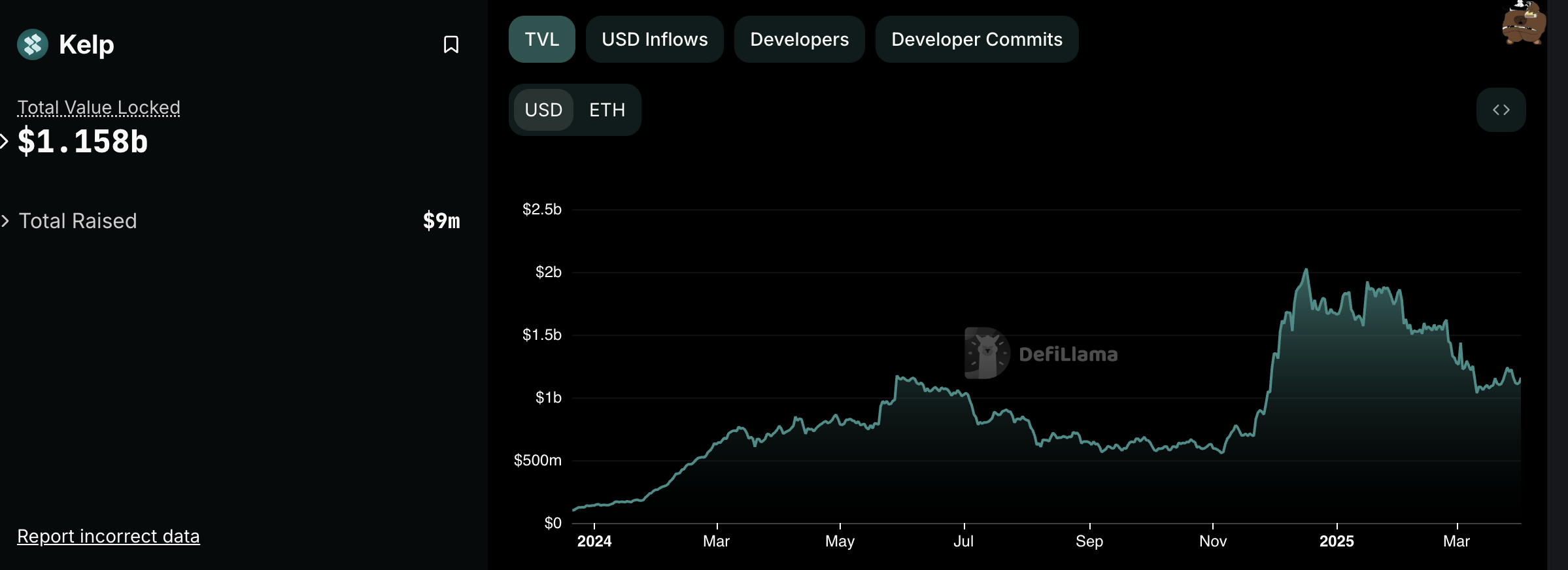
KernelDAO has a maximum supply of 10 billion KERNEL tokens. Binance has allocated 40 million KERNEL (4% of the total supply) for participants. Upon listing on Binance, the initial circulating supply will be 162,317,496 KERNEL (16.23% of the total supply).
After the Megadrop event, KERNEL will be listed on Binance Spot with trading pairs such as KERNEL/BTC, KERNEL/USDT, and KERNEL/BNB.
KernelDAO is the fourth project on Binance Megadrop, following Lista (LISTA) and Xai (XAI). Previously, Binance Labs invested in Kernel to build recovery infrastructure on the BNB Chain.
Binance’s inclusion of KernelDAO could contribute to the growth of the restaking sector. According to DeFiLlama, the total TVL of restaking protocols surpassed $15 billion in early 2025, with EigenLayer and Kelp leading the market.
With 40 million KERNEL tokens distributed through Megadrop, many participants may sell immediately after receiving their tokens, potentially creating downward price pressure. Additionally, increasing competition from protocols like EigenLayer could pose challenges for KernelDAO.
Additionally, not all projects listed on Binance have performed impressively. In 2024, Binance-listed tokens all fell, with 29 out of 30 tokens posting significant losses.
Disclaimer
In adherence to the Trust Project guidelines, BeInCrypto is committed to unbiased, transparent reporting. This news article aims to provide accurate, timely information. However, readers are advised to verify facts independently and consult with a professional before making any decisions based on this content. Please note that our Terms and Conditions, Privacy Policy, and Disclaimers have been updated.
Market
Wintermute Sells ACT Tokens Due To Binance Limit Changes

Market maker Wintermute sold off huge quantities of ACT and other BNB meme coins on April 1, tanking their prices by as much as 50%. Wintermute CEO denied intentionally selling these assets and started re-buying them.
Community sleuths believe that Binance is to blame, quietly lowering the leverage position limit for ACT and other tokens. This incident may cause further mistrust and uncertainty in a shaky meme coin market.
Why Did Wintermute Sell ACT?
A chaotic incident is currently unfolding in the meme coin sector. At the center of the story is Wintermute, a market maker that recently made headlines by interacting with World Liberty’s USD1 stablecoin before the official announcement.
Today, Wintermute has sold off large quantities of BNB meme coins, especially ACT.
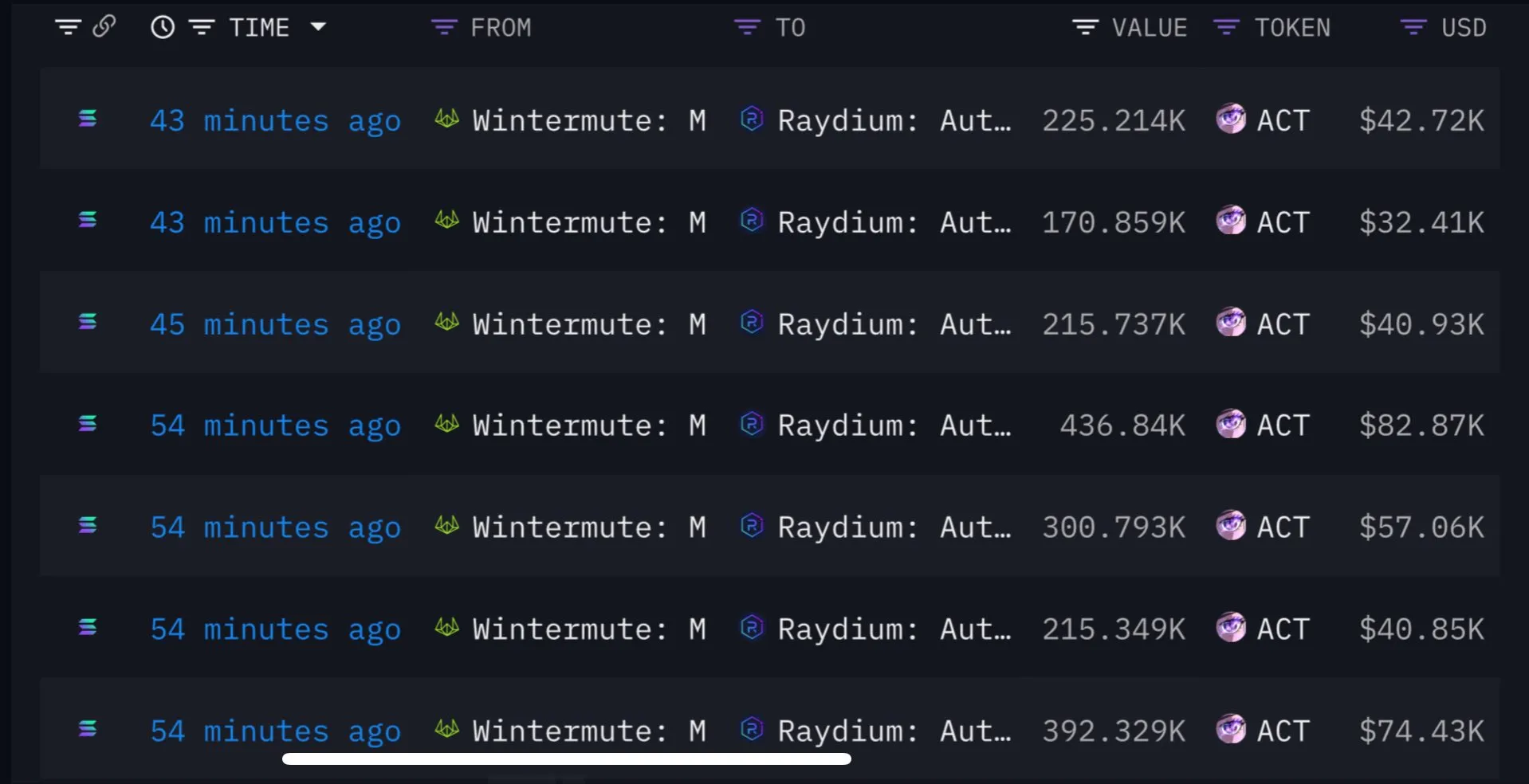
After Wintermute’s massive sell-off, the price of ACT subsequently fell 50%. This caused a stampede in other BNB meme coins, erasing millions of dollars and generating a lot of market chaos.
However, in a strange development, Wintermute’s CEO Evgeny Gaevoy denied deliberately causing the sale.
“Not us, for what it’s worth! [I’m] also curious about that postmortem. If I were to guess, we reacted post move, arbitraged the Automated Market Maker (AMM) Pool,” Gaevoy claimed in a social media thread.
This raised more questions than it answered. If Wintermute didn’t intend to sell off these ACT tokens and other meme coins, what triggered them? The firm even began buying ACT again after the sale. Subsequently, crypto sleuths started suspecting a quiet rule change from Binance, the world’s largest crypto exchange.
Both data from Lookonchain and analysis from 0xwizard, an important community leader for ACT, alleged that Binance was involved in the Wintermute debacle. Specifically, they claimed that the exchange quietly lowered the leverage position limit for ACT. This meant that market makers who held more positions than this limit were automatically liquidated at market price.
Naturally, these allegations caused a lot of outrage. Yi He, co-founder of Binance, responded, claiming that the relevant team is “collecting details and preparing a reply.” She further said that there might be another player involved but didn’t elaborate on this. This is not her first time responding to major criticism about Binance’s meme coin policies.
Ultimately, the dust is far from settled on this issue. Most of the impacted tokens are still substantially down from their positions yesterday, which is unfortunate in this fearful market. Between HyperLiquid’s short squeeze last week and this incident with Wintermute and ACT, overreach from crypto exchanges could damage market confidence.
Disclaimer
In adherence to the Trust Project guidelines, BeInCrypto is committed to unbiased, transparent reporting. This news article aims to provide accurate, timely information. However, readers are advised to verify facts independently and consult with a professional before making any decisions based on this content. Please note that our Terms and Conditions, Privacy Policy, and Disclaimers have been updated.
-

 Ethereum22 hours ago
Ethereum22 hours agoEthereum May Have To Undo This Death Cross For Bull’s Return
-

 Market22 hours ago
Market22 hours agoBlackRock’s Larry Fink Thinks Crypto Could Harm The Dollar
-

 Market21 hours ago
Market21 hours agoCoinbase Tries to Resume Lawsuit Against the FDIC
-

 Altcoin21 hours ago
Altcoin21 hours agoCharles Hoskinson Reveals How Cardano Will Boost Bitcoin’s Adoption
-

 Market20 hours ago
Market20 hours agoHedera (HBAR) Bears Dominate, HBAR Eyes Key $0.15 Level
-

 Altcoin24 hours ago
Altcoin24 hours agoElon Musk Rules Out The Use Of Dogecoin By The US Government
-
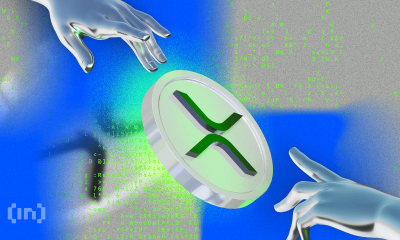
 Market23 hours ago
Market23 hours agoXRP Bears Lead, But Bulls Protect Key Price Zone
-

 Altcoin22 hours ago
Altcoin22 hours agoEthereum Bitcoin Ratio Drops to Record Low, What Next for ETH?





















